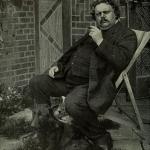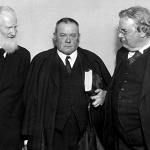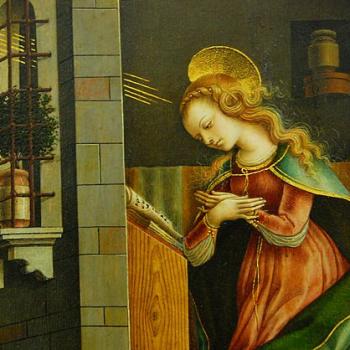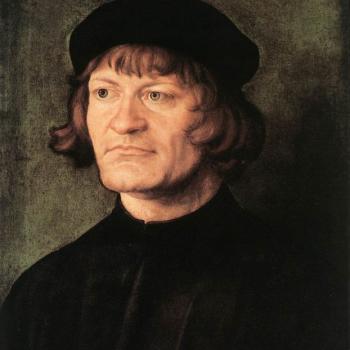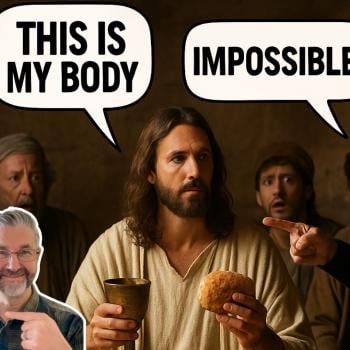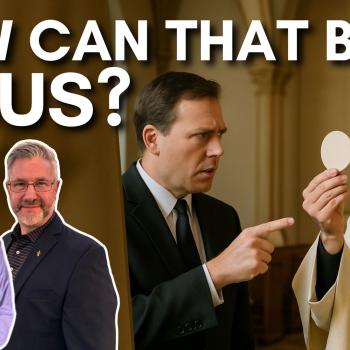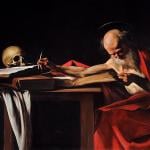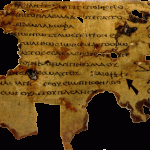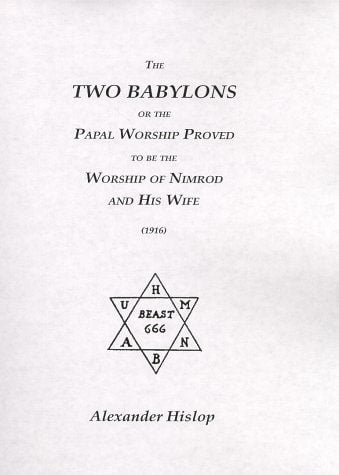
Cover of a 1919 edition of Hislop’s The Two Babylons [public domain / Wikimedia Commons]
(1-25-91)
The Two Babylons, by Alexander Hislop, is a particularly venomous and well-known book simply teeming with ignorance and falsehood. This “scholarly” work, published in 1858 (Neptune, New Jersey: 1959, 2nd American edition, 330 pages), gives its “thesis” in the Introduction:
It has been known all along that Popery was baptized Paganism . . . the very Paganism which prevailed in the ancient literal Babylon . . . the chief seat of idolatry under the New Testament . . . The essential character of her system, the grand objects of her worship, her festivals, her doctrine and discipline, her rites and ceremonies, her priesthood . . . have all been derived from ancient Babylon; and finally, that the Pope himself is truly and properly the lineal representative of Belshazzar . . . She must be stripped of the name of a Christian Church altogether. (pp. 2-3)
Hislop interprets a passage in Newman’s Essay on the Development of Christian Doctrine utterly falsely, to the effect that Mary was to be “worshipped as a partaker of the Godhead” (p. 83). Of course, this is absurd, as Mary is a creature in Catholicism — albeit the highest and only sinless one — but still infinitely distinct from the transcendent God and in need of salvation and God’s grace just as we all are. She is venerated, but not worshiped, a distinction understood by even the most nominal Catholic.
This book is such a catalogue of error and falsehood that practically any page could be used as an example of folly, but we shall look at only two more here. Hislop feels that “the real character of the god whom the Papacy has set up for the worship of its deluded devotees . . . is Moloch, the god of barbarity and blood” (p. 150).
The conclusion of this remarkable book illustrates Hislop’s prejudice and ignorance and refutes itself:
Let it be recognized and regarded as the Mystery of Iniquity, yea, as the very synagogue of Satan . . . Popery boasts of being the ‘old religion,’ . . . It can trace its lineage far beyond the era of Christianity, back over 4000 years, to near the period of the Flood and the building of the Tower of Babel. During all that period its essential elements have been nearly the same. (pp. 282, 287)
The Two Babylons is based on a simple false premise, i.e., whenever a practice, custom, or belief of Catholicism has the least similarity with a “counterpart” in paganism, then the Catholic version must be essentially identical with paganism. The book is laced with childish pictures comparing items, supposedly proving their “lineage” and affinity (e.g., the pope’s tiara, or crown). This method violates two accepted fallacies of logic: the “genetic” fallacy, in which the source of an idea is opposed rather than the idea itself; and the fallacy of correlation = cause, where similarity “proves” that one view derived from another earlier one (and carries all the same interpretations also).
Furthermore, it betrays a complete noncomprehension of the impulse of Catholicism, whereby it affirms all that is good in paganism, or else absorbs and “Christianizes” it. This is merely practical wisdom and genius. For instance, Christmas, as is well known, was celebrated on the same day as a Roman feast, so as to make the people forget the pagan feast. What better way to overcome old customs? Such a lack of intellectual prowess in this book and others like it, leads one to suspect that the authors’ blinding prejudice, as to what they think is Catholicism, as Fulton Sheen said, is the predominant motivation behind the writing.
Roman Catholicism, by Loraine Boettner (Philadelphia: Presbyterian & Reformed, 1962, 466 pages), is an obscurantist diatribe, the current “Bible” of anti-Catholicism. It describes within its pages a religion bearing little resemblance to the one which is known by its title. Catholic apologist Karl Keating, whose book Catholicism and Fundamentalism (San Francisco: Ignatius, 1988) is an excellent expose of the overwhelming misinformation of anti-Catholicism, as well as a fine apologetic for Catholicism, gives an idea of the scholarly “weight” of this regrettable “tome”:
The main problem . . . is that it suffers from a real lack of intellectual rigor. For example . . . there is no indication that he has made use of any hardheaded apologetic works by Catholics . . . His major sources are people who do not just disagree with Catholicism but who openly oppose it . . . Boettner accepts at face value any claim made by an enemy of the Church . . . In the whole book there are only two dozen footnotes . . . references to Catholic works are usually so vague as to discourage checking . . . The Catholic position . . . has been entirely misstated . . . he must give a parody of the Catholic view, and then he refutes that . . . There are literally hundreds of errors of fact in this book . . . (pp. 29-31, 33)
A few examples of the folly ever-present in this work:
The feeling of fear and dread of the priest, so characteristic . . . is comparable only to the fear and dread that pagan people have for the witch doctor. (p. 53)
The Catholic doctrine of the Eucharist is the same as “cannibalism” (p. 176). Mary is “a kind of fourth person of the Blessed Trinity” (p. 151). He states that “It is generally accepted that Romanists, having been to Mass . . . can do about as they please the remainder of the day” (p. 184).
Boettner concurs with another writer that “the intellectual and moral level of priests is not nearly as high as, for instance, that of teachers and doctors, and . . . only a minority share any exceptional ability or deep religious feeling” (p. 59).
Boettner cites a book to the effect that young women who enter the convent are taught to hate their parents (p. 323). If anyone is persuaded by this manner of “reasoning” and the “conclusions” resulting therefrom, it is probably futile to pursue any rebuttal.
The late Keith Green, who died tragically in a plane crash in 1982, was a very popular Christian singer and evangelist (and a big influence on me in many beneficial respects, as he was for many evangelicals). I seriously considered joining his ministry in 1982. Much of his teaching is quite edifying, and his wife Melody has been a major force in the pro-life movement. Regrettably, however, his Catholic Chronicles of 1980-81, fell prey to some of the common misunderstandings of Catholicism. In fairness, it must be mentioned that these tracts were later discontinued by Last Days Ministries, but they no doubt had their effect.
Green states in the Introduction to the series: “Nowhere has such departure from scriptural truth been so tolerated, accepted, and made into tradition and pillars of Church doctrine as in the Roman Catholic Church” (Last Days Newsletter, November/December 1980, “Introduction to the Catholic Chronicles,” p. 13).
In his tract on The Holy Eucharist, Green takes exception to the Real Presence and transubstantiation and shows an appalling ignorance of Church history (a tendency common to virtually all anti-Catholics and, sadly, far too many Protestants in general). He implies that the doctrine was controversial and vague up until it was proclaimed a dogma in 1215. In fact, the Real Presence was universally believed by all Christians of note until Protestantism began. The early Christians were called “cannibals” by the pagans for this very reason. Transubstantiation, a consistent development of the Real Presence, was explicitly stated by Church Fathers Cyril of Jerusalem (d. 387), Gregory Nyssa (d. 394), John Chrysostom (d. 407), Cyril of Alexandria (d. 444), and Ambrose (d. 397) ( see Ludwig Ott, Fundamentals of Catholic Dogma, Rockford, Illinois: TAN Books, 1974, 381-382).
Green cites Tertullian as an historian of the “Middle Ages.” Tertullian died around 230 A. D., long before the Middle Ages, by anyone’s reckoning. The Eucharist is later said to be prefigured in the worship of Osiris and in Mithraism (Hislop-type fallacious “reasoning” again). The second Chronicle, The Sacrifice of the Mass, (Last Days Newsletter, Nov/Dec 1980, pp.23-27) is subtitled “Jesus Dies Again.” Catholic doctrine has never held that Jesus dies every time a Mass is celebrated (although this is the constant accusation). Rather, as Karl Adam writes, “Christ our high priest sacramentally re-presents the sacrifice which He once offered on Calvary” (The Spirit of Catholicism, translated by Justin McCann, revised edition, Garden City, New York: Doubleday Image, 1954 [orig. 1924], 135). This could have been found out in any basic introduction to Catholicism or Catechism.
The problem is that the anti-Catholics never seem to consult the very works with which they should begin their analysis. They have their own networks of disinformation which facilitate a regurgitation of the same old lies over and over again — the same tactics which Luther himself perfected. Invariably, however, Catholic teaching is much more subtle, fine-tuned and complex than its detractors think. Chronicle III, Salvation According to Rome (Last Days Newsletter, January/March 1981, pp. 10-20) ends after shallow arguments, in a self-righteous tone belying the modicum of moderation preceding it:
The Roman Catholic Church has constructed one of the most unbiblical doctrinal systems that has ever been considered ‘Christian.’ The fear, anguish and religious bondage that such a system . . . creates, has tormented millions of lives for centuries, and continues to prey on those who are ignorant of the biblical way of salvation . . . Never has something so black and wicked, gotten away with appearing so holy and mysteriously beautiful . . . for so long!
Green recommends Boettner’s book (obviously his primary source) to all as “a valuable resource for reference,” giving the author’s address and highlighting it in a separate “box”. It is also quoted from at great length at the end of Chronicle IV, What Did Vatican II Really Change? We have already examined the quality of Boettner’s “scholarship.”
No survey of anti-Catholicism is complete without reference to Jack Chick and Chick Publications, and its notorious comic booklet “Alberto” (with myriad sequels). Here we pass from ignorance and lack of serious study to outright farce and absurdity. Alberto Rivera claimed to be a Jesuit priest, but has decisively been shown to be a total fraud in evangelical magazines Cornerstone (vol.9, no. 53, “The Alberto Story,” Gary Metz, pp. 29-31) and Christianity Today (13 March 1981, also by Gary Metz).
According to Rivera, the Jesuits assassinated Abraham Lincoln and trained Marx, Engels, Lenin and Stalin; Hitler was a pawn of the Vatican, which was also behind both World Wars. Billy Graham is a Vatican agent, and the Ku Klux Klan, Nazis, Communists and Masons were or are secretly directed by the Jesuits. Oh, and the Jesuits, conspirators that they are, also wrote the Koran! As of April 8, 1989, the date of an article on the subject in the Detroit News (Kate DeSmet: “Comic Book Series Gets No Laughs From Christian Groups”), nearly half of twenty metropolitan Detroit Christian bookstores carried these magazines. This, more than anything, gives an idea of the magnitude of the problem here dealt with. See also my paper, The Real Alberto Rivera (edited, with commentary, by Dave Armstrong, from articles by Protestant Gary Metz).
Related reading:
Inaccuracies of Anti-Catholic Foxe’s Book of Martyrs
Anti-Catholic Polemicist Bart Brewer’s Initial “Reason” for Leaving the Catholic Church
Sola Scriptura: Unbiblical!: Refutation of Dr. Richard Bennett
Critique of Ankerberg & Weldon’s Anti-Catholicism
Refutation of Dr. John MacArthur’s Sola Scriptura Defense: “The Sufficiency of the Written Word”
Sam Shamoun: Catholic Inquisition Murdered “50-68 Million”
Why Transubstantiation Isn’t Idolatry At All
*****


